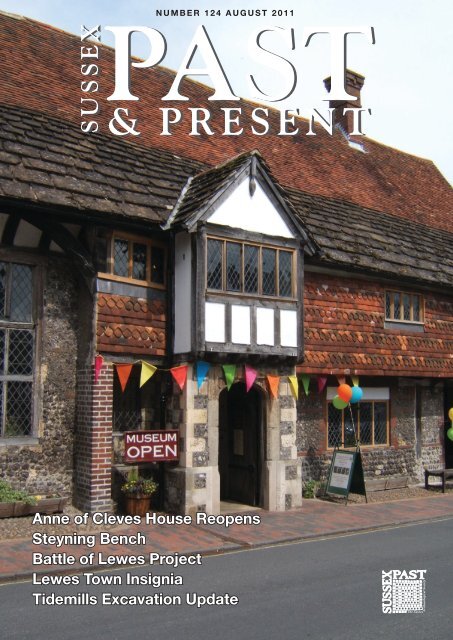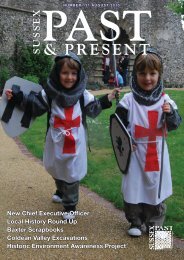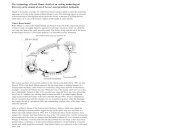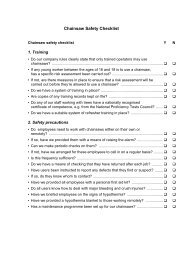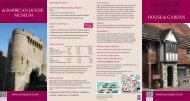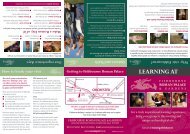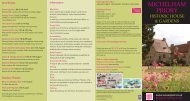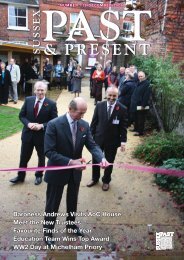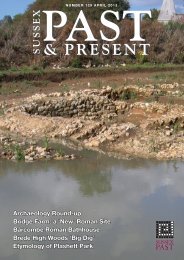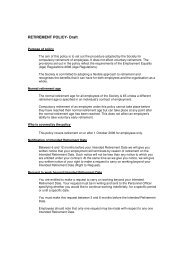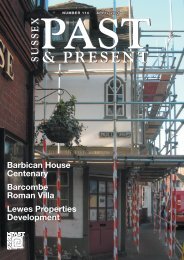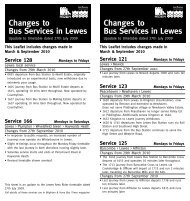August 2011 (issue 124) - The Sussex Archaeological Society
August 2011 (issue 124) - The Sussex Archaeological Society
August 2011 (issue 124) - The Sussex Archaeological Society
Create successful ePaper yourself
Turn your PDF publications into a flip-book with our unique Google optimized e-Paper software.
Membership MattersMEMBERSHIPOPENING LINESOpening LinesLorna’s NotebookA round-up of all that’s new in the membership departmentWelcome to the <strong>August</strong> editionof <strong>Sussex</strong> Past & Present.Autumn Conference: <strong>The</strong>South Downs – the shaping ofa landscapeSaturday 17 SeptemberIn the year in which the SouthDowns National Park becameofficial, it seemed only right thatit should be the theme of thisyear’s autumn conference. <strong>The</strong>day promises a broad look at themany factors that have shaped theDowns as we see them now, fromprehistoric times to the present, andwe have many notable speakers. Ifyou have misplaced the leaflet andbooking form included with theApril newsletter, you can still bookthrough the Noticeboard of thisedition of <strong>Sussex</strong> Past & Present,online via our website or by phone(01273 405737, Tuesday – Friday10am – 3pm).Visiting the LibraryOne of the benefits that membershave is the right to visit the Libraryin Barbican House whenever theMuseum is open – non-members areonly given access from Monday toFriday, when the Library volunteersare in. However, there have beena couple of occasions recentlywhere newer members, unfamiliarwith the Library, have visited at theweekend and requested assistancefrom the custodial staff. Sadly,much as they are willing to help,their duties make it hard for themto leave the admissions desk andthey are not, in any case, able toassist with finding resources in theLibrary. We do advise you to comein on a weekday for your first visit,before you are let loose on yourown at the weekend! It will makeyour journey much more profitable.We do organise a special tour ofthe Library for members who areunfamiliar with it, and the next onewill be in November. It’s free, andmore details are in the Noticeboard(centre pages). Space is limited, sowe do ask you to book in advance.Membership Office closure inSeptemberImmediately after the Septemberconference, the MembershipDepartment will be closed for twoweeks for me to go somewherewarm to recover! You may leavemessages on the answerphone, butthe best way to get in touch will beby email (members@sussexpast.co.uk ) or by post. <strong>The</strong>re will beno cover in my absence, whichmeans there will be some delaysin handling everything when I getback, but I will do my best to keepeverything running smoothly.Battle of Lewes ConferenceSaturday 14 April 2012As part of the three year Battle ofLewes project, supported by theHeritage Lottery Fund, we will beholding a one day conference inApril next year. Further details areincluded with the booking form,and we do expect this to be a verypopular event, with a fascinatingvariety of talks looking at a broadspectrum of topics related to theBattle of Lewes, which will becelebrating its 750 th anniversary in2014.Will For FreeEach <strong>August</strong> we distribute a copy ofthis leaflet to encourage those of youwho might be prepared to considerleaving the <strong>Society</strong> a donation, ofwhatever size, in your will. A smalllegacy can make a great differenceto the <strong>Society</strong>, and we would urgeyou to give this some thought. <strong>The</strong>contents of your will remain entirelyconfidential between you and thesolicitor.Wooded LandscapesConference – transcripts &LiDARI am delighted to say that transcriptsof the talks given at this conferenceare now being posted online atthe High Weald AONB websitewww.highweald.org. It is a timeconsumingprocess preparingand checking these, so we areuploading them as they are ready.If a particular talk is not there whenyou look do check back later.<strong>The</strong>y will be also uploaded to the<strong>Society</strong>’s website when the newsite is launched later this summer.In addition, the Weald Forest RidgeLiDAR is now available online inthe downloads section of the HighWeald website. Currently they areonly available by grid references,but this is likely to change in thefuture.Lorna GartsideMembership SecretaryFor all membership enquiriesand to apply, please contactMEMBERSHIPDEPARTMENTBull House,92 High StreetLewes, <strong>Sussex</strong> BN7 1XHTues-Fri 10.00am-3.00pmAnswering machineoutside these hours01273 405737Email:members@sussexpast.co.ukSUSSEXPast &Present<strong>The</strong> <strong>Sussex</strong> <strong>Archaeological</strong><strong>Society</strong> NewsletterN u m b e r 1 2 4A U G U S T 2 0 1 1Contents2 Membership matters3 Opening lines4 Anne of Cleves re-opens5 John Magilton6 Steyning Bench7 Margary Grants8 Battle of Lewes project9 Fishbourne news10 Tidemills excavation11 Landscapes of Governance12 Library & Bookshop13 Lewes Town Insignia14 Book reviews15 Book reviews16 SnippetsPublished by the <strong>Sussex</strong><strong>Archaeological</strong> <strong>Society</strong>, BullHouse, Lewes, E <strong>Sussex</strong>, BN71XHTel: 01273 486260Fax: 01273 486990Email: lamo@sussexpast.co.ukEditor: Wendy MurielEmail: spp@sussexpast.co.ukResearch Editor: Luke BarberISSN 1357-7417Cover: Anne of Cleves House Museumofficial reopening on 7th May <strong>2011</strong>.Photo: Wendy MurielYour <strong>Society</strong>What you can do to help!Dear MembersI would like to share with you some of the significant current business<strong>issue</strong>s we face and the plans which are being put in place to take theorganisation forwards. I would encourage you to read the MembersReport from the <strong>2011</strong> AGM – this can be found on the website, in themembers section. This will give you a very clear idea of the work of theTrustee led committees as well as giving you an overview of the <strong>Society</strong>’sactivities during the last year.One key area which I would like to draw your attention to is the verychallenging financial situation we face. We anticipate that the <strong>Society</strong>will post a deficit in the region of £170,000 for this financial year. <strong>The</strong>Trustees and I have put in place a business development plan for thenext year and this does give us a framework for positively developing ourbusiness. We are currently working on the key priority areas, for examplethe development of better marketing (a new website is currently beingdeveloped) and new interpretation on our sites. However, these activitiescannot produce instant results and it is likely that the next two years willbe difficult ones for the <strong>Society</strong> from a financial perspective. One of thekey messages I want to share with you is that there is no cavalry riding toour rescue and there are no magic solutions possessed by one individualor group within the <strong>Society</strong>. It is down to us now collectively to ensurethat this wonderful entity thrives and prospers well into the future. <strong>The</strong><strong>Society</strong> is rich in people and if we all take some action then the collectiveimpact will be very significant.<strong>The</strong>re are some simple, practical things you can do. Help us promoteour membership - ask Lorna, our Membership Secretary, for somemembership leaflets and hand these out to friends and groups you know,give membership to the <strong>Society</strong> as a present to friends or relatives.Consider making a donation in your will to the <strong>Society</strong>. I am planningto do this myself. If you have not already made a will or would like tochange your current one free of charge, please do use the Will For Freeleaflet enclosed. This is a long term way in which help can be providedand which many years from now I hope provides my successor with aregular source of income to support our activities. Consider volunteering– we have many activities and events where extra pairs of hands arevery helpful. If you have professional skills and knowledge which youthink may be of help then please contact myself or Jane Vokins, Chair ofCouncil. Do you work for or know any organisations who may sponsor orsupport our activities? <strong>The</strong>se are just some suggestions, we welcome allideas and ways in which you think you may be able to help.<strong>The</strong> staff, Trustees, volunteers and Friends groups are working veryhard to take the <strong>Society</strong> forwards. We have excellent sites, collections,resources and people. Come and work with us to make the future as richand interesting as our past.Tristan BarehamChief Executive <strong>Sussex</strong> Past & Present <strong>August</strong> <strong>2011</strong>www.sussexpast.co.uk www.romansinsussex.co.uk <strong>Sussex</strong> Past & Present <strong>August</strong> <strong>2011</strong>
FeatureANNE OF CLEVES HOUSEJOHN MAGILTONResearch ObituaryAnne of Cleves Re-opensOfficial Re-opening of Museum on 7th May <strong>2011</strong><strong>The</strong> re-opening of Anne ofCleves House was celebratedon Saturday 7th May with a privatereception to thank the stakeholdersinvolved followed by a Tudor EventDay which attracted visitors bothfrom Lewes and further afield.<strong>The</strong> house has undergone arenaissance due to the sterling workof contractors, staff and the Friends<strong>Society</strong>, all of whom have pulledtogether to get the house ready tore-open for the <strong>2011</strong> season.Gone are the cobwebs andbuilders’ dust and scaffolding, andfreshly painted walls glow cleanand bright. <strong>The</strong> work has giventhe society an opportunity to havea think about the house and thecontents on display within it, tore-assess why people come hereto visit the property and what theywant to gain from their visit. Nolonger a seemingly unconnectedcollection of differing artefacts indifferent rooms, the spaces havebeen re-designed and displayed togive the visitor a better all aroundexperience.Interior view showing new windows.Photo: W MurielNew interpretation panels explainabout the house, why it is there,its architecture and its importanceto other relevant buildings in thesurrounding area such as the nowruined Lewes Priory.<strong>The</strong> removal of the tapestries andpainted wall hangings in space at theRear elevation of the House freshly painted after renovation.far end of the bedroom, necessarydue to work on the windows andframes hidden away behind them,have given the Bedroom a newfeeling with more light flooding in.A young visitor learns how to spin.Photo: W MurielStoryboxes nestled amongstthe displays in the different roomsdraw the curiosity of both childrenand adults alike as part of a projectnamed ‘Bringing the House to Life’,Photo: W Muriel with activities for young and oldto enjoy, explore and gain furtherinformation about life from C.1460onwards.Having a ‘Tudor Housewife’ in thehouse (a member of the educationdepartment in reproductioncostume) is one of the new initiativesbeing trialled and evaluated in anattempt to bring visitors a betterunderstanding of the house and itsuse over the centuries and is partof ongoing initiatives to improvethe visitor experience.Tudor woodworking demonstration.Photo: W MurielBut it must be remembered thatit is not just the House, Garden andits contents that ‘speak out’ to thepaying visitor. Custodians and reliefstaff all have their part to play inensuring that visitors get to enjoywhat they come and see. It is up tous to help promote the <strong>Society</strong>, ourother properties, any events thatwe have on our sites and to help usfinancially by promoting Gift Aid andMembership. A happy customeris worth their weight in gold andalthough the benefits may not beseen immediately, a good reputationand word of mouth will encouragemore visitors and increasedbookings. A helpful person on thefront desk, with a kind word or twoand a friendly, helpful attitude maysubconsciously encourage a saleor two in the adjoining gift shop.Entrance hall with new desk and displayshelving.Photo: W Muriel<strong>The</strong> Friends of Anne of Cleveshave been very generous in theirsupport of the project, paying for anew desk and shelving for the shoparea in the centre of the house.Dark and dusty velvet curtainshave been replaced with brightpanels of Crewel work embroidery,much more fitting for the 15th and16th Centuries. A new pavilion tentis also on its way from Nottinghamto grace the garden for Weddingsand Events during the summerthanks to the fund-raising from theFriends’ <strong>Society</strong>.Isobel RobertsSenior CustodianJohn Roland MagiltonBA MPhil FSA MIfA1951-<strong>2011</strong>John Magilton was of Irish ancestry but was born in north Wales, in1951. He discovered a love of archaeology and all things Romanand medieval whilst at school in Chester and went on to study medievalhistory and archaeology at Southampton University and to researchancient history and archaeology at the University of Birmingham(where his MPhil thesis was awarded the Constance Naden medal).He worked in the field in the 1970s and 80s, during the formativeyears of British professional archaeology, directing excavations atYork and Doncaster and in Warwickshire and Lincolnshire. In 1985he became District Archaeologist in Chichester, where he turnedthe city Excavations Unit into a fully professional organisation andsuccessfully led it into the era of PPG16 and competitive tenderingwhile insisting on continued amateur involvement. From 1999 heworked as a consultant, mainly writing up unpublished excavations,and as a part-time adult education tutor in Hampshire and West<strong>Sussex</strong>.Wherever he went, John’s positive contribution to archaeologywas not just in his leadership and the quality of his fieldwork butalso in that of its publication. By virtue of his work on Roman andmedieval temples, churches and cemeteries, he was something ofan expert on the archaeology of religion and burial, as he was tooon urban archaeology; however he could turn his hand to the studyof medieval history and standing buildings, Roman and medievalpottery, post-medieval industry and, in a rare foray into the prehistoric,evidence for the practice of tattooing. He was able to reinventhimself as a specialist in medieval leprosy and, latterly, Roman bathhouses.<strong>The</strong>re is not room to list all his publications; for <strong>Sussex</strong> thehighlights are the internationally important excavation and analysisof the cemetery of the Hospital of St James and St Mary Magdalenein Chichester, as well as his various publications on Roman andmedieval Chichester, in particular its defences. Of more strictly localsignificance were his monographs on the archaeology and history ofMidhurst (with Spencer Thomas) and of Fernhurst Furnace. Shortlybefore his death he was working on an article exposing the identityof William Sabatier, Chichester’s first archaeologist.While always demanding the highest standards in recording,analysis and publication he could see the good in everybody andregarded it as part of his responsibility, as of all archaeologists, toencourage local involvement indiscriminately. He regarded loyaltyas the requisite of the manager – and was, typically, rather surprisedand slightly embarrassed when he received it from his staff. All whoknew him will miss his unassuming cleverness and impish sense ofhumour.He died on 24th March <strong>2011</strong>.James KennyArchaeology Officer, Chichester District Council <strong>Sussex</strong> Past & Present <strong>August</strong> <strong>2011</strong>www.sussexpast.co.uk www.romansinsussex.co.uk <strong>Sussex</strong> Past & Present <strong>August</strong> <strong>2011</strong>
FeatureSTEYNING BENCHMARGARY GRANTSResearchFine Dining at Earlier AGMs?Old journal reveals accusations of neglect and excess!Mr Leslie Stevens of UpperBeeding contacted me inJanuary <strong>2011</strong>. He owns a boundcopy of <strong>The</strong> Building News, 22,(Jan-June 1872), and on page 152of the 23 February 1872 <strong>issue</strong> thereis a drawing of an ‘Oak Bench,Steyning, <strong>Sussex</strong>’, reproducedhere. <strong>The</strong> writer and illustrator,Maurice B. Adams, writes:-<strong>The</strong> oak bench illustratedthis week is stored awayin the Tower of SteyningChurch; it is a good exampleof old English furniture, andcertainly worthy of a betterplace than that assigned to it,though now in a dilapidatedcondition. Its style appearsto be Elizabethan, or earlyJames I; I should, however,be glad if any one would givetheir opinion as to its date.<strong>The</strong> bench, or part of a pew, hasa locked compartment within theseat. Sadly, it no longer residesin the tower, or indeed anywhereelse in the church of St Andrew &St Cuthman, Steyning - and manythanks to the bell-ringers for theirrecent tower investigation. A furthersearch in <strong>The</strong> Building News revealsan indignant reply in the March 1st<strong>issue</strong>, page 184, the writer beratingthe <strong>Sussex</strong> <strong>Archaeological</strong> <strong>Society</strong>in fulsome terms:-Ancient Oak Furniture.Sir, I quite agree with yourcorrespondent, Mr M. B.Adams, in his remarks on theOak Bench, Steyning, <strong>Sussex</strong>,accompanying his illustrationin your last week’s number,that “it is worthy of a betterplace” than being storedaway in the church tower.<strong>Sussex</strong>, I believe, boasts ofan <strong>Archaeological</strong> <strong>Society</strong>,but the chief use of it seemsto consist in occasionallygoing to look at antiquitiesand eating a good dinner.<strong>Sussex</strong> is rich in antiquities– no county is more so – andto this circumstance we mustaccount the fact that familiaritybreeds its contempt for them,for no county in Englandtreats its ancient treasureswith more indifference andneglect than does <strong>Sussex</strong>– Hastings Castle to-wit.In Parker’s Glossary is anexcellent plate of an ancientFlamboyant oak chest,formerly in Guestling Church,<strong>Sussex</strong>. While travelling inthat neighbourhood in 1865, Ivisited this church and askedto see this chest, when, to mysurprise, I was told that it hadbeen recently destroyed, andon making further inquiries Ifound that this was actually thefact, and the last panel of thisbeautifully-carved chest was,like our friend in Steyning,“stored away in the tower”,where I saw it. I think it timethat archaeological societiesshould use their influence (ifthey have any) to preservethese relics of the past, andthus show their practicalnecessity for existence, andnot to become, what manyare beginning, to suspect,(sic) mere sponging societieson those who will give them agood luncheon. I am etc.W. F. Potter, Feb 26Mr. Stevens (aged 95) kindlyloaned the book for copies tobe taken for Steyning Museumarchives. I spent some time lookingthrough <strong>Sussex</strong> <strong>Archaeological</strong>Drawing of the oak bench at Steyning Church, reproduced from <strong>The</strong> Building News of February1872.Collections, 12-25, (1860-1873) todiscover any examples of <strong>Society</strong>sponging or over-indulgence ingood luncheons. Neither Mr Potternor Mr Adams appear to have beenmembers of the <strong>Society</strong>. A searchon www.ancestry.co.uk did notreveal a Mr W F Potter on the 1851-1881 <strong>Sussex</strong> Census Returns. Ihad hoped he might have beenWalter Potter of Bramber Museum(of taxidermy fame), but he had nomiddle name, according to his DNBentry.<strong>The</strong> SAS Secretaries reportedon several meetings every year allover the county. <strong>The</strong>se includedexamination of numerous churches,houses and archaeological remains,and, in one case, even somefurniture, at Maresfield Rectory,organised by the Revd EdwardTurner at the May 1859 Uckfieldmeeting. It would be tedious to listall the events, which can be easilyread in SAC volumes, but a fewthat mention dining, are describedbelow.<strong>The</strong> <strong>Society</strong> usually had its AGMon 8 <strong>August</strong> each year, and ‘dinnerin their tent’ was quite a feature– for instance, at Pevensey Castlein 1860 when the weather washorrendous. In the same year theydid have “…an excellent dinner atthe New Inn [Hurstpierpoint] – amatter never to be disregarded bytrue archaeologists – crowned theoperations of this most satisfactoryday”. <strong>The</strong> Committee decidedto purchase ‘the capacioustent’ in 1860; it was apparentlyextremely rainproof. <strong>The</strong> cost was‘considerable’, but they hoped tolease it out occasionally to helpfinance the purchase. In 1862 theAGM was held at Hastings whenmembers visited the Castle, but nomeal was mentioned. Was Mr Potterlurking nearby? He presumablyknew the Castle and its environs.<strong>The</strong> 1864 AGM was held atSeaford, and “<strong>The</strong> more festiveportion of the day’s proceedingstook place, as usual, beneath theshadow of the <strong>Society</strong>’s well-knowntent.” In October Wakehurst Place,Ardingly Church and BalcombePlace were visited, and at the latter<strong>Society</strong> members were “…receivedby Mr and Mrs Hankey with anelegant and bountiful hospitality…”In 1865 they dined in the tent atAmberly Castle for the <strong>August</strong>AGM. A visit to the ‘old Hostelrythe Star’ at Alfriston in 1869 seemsmerely to have been to inspect thebuilding, and there is no mention offood or drink being taken. I thoughtI was going to have more luck withthe <strong>August</strong> 1870 AGM held in Ryewhen “the dinner was providedat the George Hotel… and greatsatisfaction was expressed at theprovision made…” but presumablyMargary Grants<strong>2011</strong>the members paid for it. InChichester, 1871, “<strong>The</strong> Dinner washeld at the Dolphin Hotel, underthe presidency of the Mayor, in theunavoidable absence of the LordBishop of Chichester. <strong>The</strong> meetingwas well attended”. In October therewas a trip to Withyam and Hartfieldand “Earl De La Warr hospitablyentertained the company with asubstantial luncheon at BolebrookHouse”. Could this have beenthe ‘sponging’ referred to by MrPotter, in his letter published in <strong>The</strong>Building News the following year?I have no time, unfortunately, toinvestigate this matter further, andam happy to hand it over to any<strong>Society</strong> detectives. Hopefully theantiquities of <strong>Sussex</strong> are no longertreated with ‘indifference andneglect’, though the Steyning ‘oakbench’ has long disappeared.Janet Pennington<strong>The</strong> awards for this year are listed below. If you would like to contact any of the grant holders, please askLuke Barber our Research Officer for information. His details are on the contact list in the centre pagesof SP&P. <strong>The</strong> guidelines and application form for Margary Grants are available on our website or can beposted to you by Luke. <strong>The</strong> Research Committee awards the grants and monitors their progress. <strong>The</strong> grantsare carefully supervised and receipts are expected for all claims.• Michael Fradley - £541 awarded for a magnetometry survey of Late Saxon ecclesiasticalcomplex on East Hill, Hastings .• Pevensey Court House Museum - £1,600 awarded towards the cost of an historic buildingsurvey by David Martin.• George Anelay (Volunteer Archaeology Projects Trust) - Selhurst Park Project. £1,856awarded towards post-excavation costs: C14 dating and specialist reports.• David Worsell - £600 awarded for emergency/stabilisation conservation work on finds fromthe Bishopstone early Anglo-Saxon cemetery.• David Rudling - £500 awarded for additional environmental work at Barcombe Roman Villa.Total awarded for <strong>2011</strong>: £5097 <strong>Sussex</strong> Past & Present <strong>August</strong> <strong>2011</strong>www.sussexpast.co.uk www.romansinsussex.co.uk <strong>Sussex</strong> Past & Present <strong>August</strong> <strong>2011</strong>
FeatureBATTLE OF LEWESFISHBOURNE NEWSResearch Feature<strong>The</strong> Battle of Lewes ProjectOutlining plans to celebrate the 750th anniversary of the BattleBritain’s first shaky attempt atrepresentative governmentwas the result of Simon deMontfort’s victory at the Battle ofLewes, fought in 1264, which willcelebrate its 750th anniversaryin 2014. Lewes Castle’s Battleof Lewes Project, funded by theHeritage Lottery Fund, aims toprepare for this by giving people inour community the resources, fundsand space they need to generatetheir own authentic response tothis internationally important Lewesevent. Since its launch in May lastyear the project has brought over150 new volunteers of all ages toLewes Castle and over 35 differentcommunity groups. <strong>The</strong>ir work issupported by the education teamat the Castle together with otherspecialist staff.<strong>The</strong> results have beenextraordinary. Amongst theachievements so far we have a newcommunity tapestry in productiondesigned by artist Tom Walkerinvolving over 50 embroiderers,spinners, weavers and dyers, aselection of new audio material forthe website ranging from a Castletour to a recording of the poemRichard of Almain made speciallyfor us by one of the world’s leadingexperts in mediaeval language,and a battlefield family walkdesigned by a local group of CubScouts. In the field of research weare making a new archaeologicalmap of Lewes, looking into 13thcentury political allegiances locallyand investigating the location ofwar graves. With films starringfinger puppets made by localchildren and a hilarious new filmabout medieval ale written by andstarring <strong>Sussex</strong> Downs students,children from the Lewes JuniorFilm Club and the Master Brewer ofHarveys, Miles Jenner, there really<strong>The</strong> Battle of Lewesis something for everyone in thisproject. <strong>The</strong>re is still a chance tosee our exhibition about LandportBottom at Barbican House, whichincludes the rare opportunity to seeLewes Town Council’s magnificentpainting of the battle (above) hungin natural light.So what next for the coming year?<strong>The</strong>re will be a new set of educationresources, a touring exhibitionand a new film. <strong>The</strong> SAS springconference at Lewes Town Hall on14th April 2012 will be an eventnot to be missed. Chaired by ourproject patron Baroness Andrews,the speakers will include leadingacademics in the field includingProfessor John Maddicott and ourpatron Professor David Carpenter,whose talk sold out last year. <strong>The</strong>full programme and details on howto book are in the enclosed leaflet.<strong>The</strong>re will also be our thirdBattle of Lewes Day. This eventshowcases our activities to thewider public and plays an importantrole in promoting our charitableaims and purposes. Highlights thisyear included a bones discoveryImage of painting reproduced with the kind permission of Lewes Town Councilworkshop, a guided BattlefieldBus with accompanying walk,textiles activities, children’s crafts,medieval music and the chanceto try out different weapons andarmour. Most of these activities,though supported by SAS staff,were planned and run by projectmembers and volunteers – a veryimportant indication of the dynamicand welcoming nature of the SASand what it can achieve.If you have an idea for the projectyou’d like to pursue, or if you thinkyou can help with existing projects,please get in touch with theproject manager Edwina Liveseyon battleoflewes@sussexpast.co.uk. You can also find us onFacebook at Lewes Battle and onour temporary website at http://Battleoflewes.wordpress.com.Edwina LiveseyJaane RowehlIntroducing the new director of Fishbourne Roman PalaceJaane Rowehl, who took up the post of Director of Fishbourne RomanPalace on 9th May, was previously Museum Development Officer forEast Yorkshire and Northern Lincolnshire, where she helped manage staffand volunteer teams, secure funding, and build partnerships with otherlocal community groups, tourism agencies and businesses. She alsoguided all charitable, independent museums in the area, which vary fromthe birthplace of John Wesley (the founder of Methodism) to the nationalcollection of trolleybuses, to achieve full Accreditation from the MuseumLibraries and Archives Council (MLA), which sets nationally-agreedstandards for museums.German-born Jaane was delighted to have been chosen as the newdirector for Fishbourne Roman Palace and said: “It is a real honour to bepart of, what is, in my view, the most exciting Roman heritage site in thecountry and I am very much looking forward to my new job.” Jaane firstcame to England to study archaeology at the University of Nottingham in1999. As part of the course, she completed field study training in Bulgariaand Portugal where she discovered a love for Roman archaeology. She followed up her undergraduate degree witha postgraduate Masters in <strong>Archaeological</strong> Heritage Management at the University of York, receiving a fellowshipfrom the National Trust for international research into visitor perceptions at Roman heritage sites in Britain andGermany. After university, Jaane worked for several years as a researcher and then project manager with PLB Ltd– a heritage and tourism consultancy team in North Yorkshire.Students’ spring clean helps preserveartefacts at FishbourneStudents from West Dean College near Chichester helped to preservesome of the 2000 year old artefacts at Fishbourne Roman Palacewhen a group of metal conservation mature students worked at themuseum for a week in May cleaning, checking, labelling and assessingthe approximately 1000 Roman objects that are kept in the Palace’s 22cabinets. Each object was recorded and its condition compared to asimilar audit carried out in 2003. Temperature and humidity levels werealso checked to see if they were correct and labelling was updated ifnecessary. Some objects received gentle cleaning in the Palace’sconservation laboratory.Collections Discovery Centre curator Dr Rob Symmons said, “This wasa great example of organisations working together for mutual benefit.<strong>The</strong> Palace received some valuable conservation which helped preservethese unique objects and the students experienced working in a museumenvironment. Visitors were also able to see the conservation work inprogress.”Student Natalie Mitchell said, “This was an excellent chance forStudents from West Dean College helping toconserve some of Fishbourne’s artefacts.Photo: R Symmonsstudents to work in a professional environment, alongside other experts in the field. It was a perfect opportunityto reassess changes from the previous collection survey in 2003. Fishbourne has an outstanding collection ofobjects which we were very privileged to work on.” <strong>Sussex</strong> Past & Present <strong>August</strong> <strong>2011</strong>www.sussexpast.co.uk www.romansinsussex.co.uk <strong>Sussex</strong> Past & Present <strong>August</strong> <strong>2011</strong>
ExcavationsTIDEMILLS 2010LANDSCAPES OF GOVERNANCEResearchTidemills Farmyard“... and on that farm he had some pigs”<strong>The</strong> 2010 season proved a busyone again with a mixture ofvegetation clearance, standingstructure recording and excavation.Most work concentrated on thefarmyard area situated to the northof the main village, but to the southof the stationmaster’s cottage (seeSPP No. 118). <strong>The</strong> historic mapsshowed two main buildings in thisarea (Fig. 1). <strong>The</strong> largest, a barn,was situated next to the road with along building to the south-east. <strong>The</strong>latter is shown with pens along partof its south-eastern side and wasthought to be an animal shed.Fig.1 Detail from the 1st ed. OS map showingthe barn and animal shed with four externalpens (North to the top). <strong>The</strong> area was heavily overgrownwith both the dreaded knotweedand every manner of stabbing andstinging plant imaginable (Fig. 2).Fig.3 <strong>The</strong> south wall of the barn after clearance.Targets are at 1m intervals. Photo: L BarberHowever, the upstanding remainsof the barn were soon exposed,the south gable wall surviving toFig.2 <strong>The</strong> ‘barn’ prior to vegetation clearance. over six feet (Fig. 3). This wall hadsurvived the WW2 army demolitionwell in comparison with the restof the building. This was probablydue to the army making use of theventilation holes as embrasuresfor rifles – the field of fire downthe main road to the beach beingparticularly good here. <strong>The</strong> front(west) and rear walls of the barn,along with their door fittings werealso uncovered demonstratingonce more the complex sequenceof building development.Fig.4 <strong>The</strong> animal trough at the south end of theanimal shed. Photo: L BarberApart from one wall and aparticularly large animal troughnothing of the other main buildingin the area could be seen aboveground. <strong>The</strong> trough was cleanedand recorded and found to haveseveral phases of alteration (Fig.Photo: L Barber4). A further low section of wallforming the north gable end of thebuilding was subsequently locatedand found to contain five phases ofconstruction… not bad for a wallbarely 5 metres long! As a result wegot sucked into exposing more ofthis building than was planned in anattempt to understand its complexphasing.Just over half of the building wasexposed, but this was enough toestablish its plan and development.<strong>The</strong> earliest part consisted of thewestern wall that began life as asimple boundary dividing an areaoff from the barn. Against this thebuilding was constructed, utilisingthe boundary wall to the south for itssouthern gable wall. <strong>The</strong> east sidewas open, the roof being supportedon a series of timbers resting onbrick piers. Along the entire lengthof the rear (west) wall animal troughswere built (their height suggestingcattle), closely followed by theinfilling of the north side by a flintwall between the trough and mostnortherly pier. When this first phasewas constructed is unknown, but itwas in existence by the time of the1841 Tithe map and an early 19 thcentury date is suspected.However, at some point beforethe 1870s the building wasextensively altered. Four externalpens were added (Fig. 1), each withsurrounding flint walls, a brick floorand drain. Internal changes weremade to the building at the sametime (Fig. 5) – each external penwas linked to an L-shaped cementcorridor that gave access to asmall rectangular area, presumablywhere animal bedding was held. Allthe internal cement floors appearedto have bitumen covered shingleFig.5 <strong>The</strong> animal shed looking south-west.Photo: L Barberinsulation below. All in all it wouldappear pigs had taken over thebuilding (it was renamed Mr Oink’shouse at this time by the team!). Tothe west the original animal troughwas halved in length and a newbrick path laid. By the time of the1928 OS maps the pens had gone.A wet BBQ for the team. Photo: L Barber<strong>The</strong> 2010 season was blessedwith fine weather – the oneexception being the day of theBBQ. Mr Oink’s retribution for theconsumption of sausages withinhis house?!Luke BarberResearch Officer<strong>Sussex</strong> <strong>Archaeological</strong> <strong>Society</strong>Searching for the AdministrativeOrigins of Early Medieval <strong>Sussex</strong>In <strong>Sussex</strong>, as elsewhere in England, we face the most elementaryquestions in understanding the territorial and administrativeorganization of the county. How old are the systems of local government:the shires, lathes, liberties, and hundreds? Where do they comefrom? How did the courts of these territories work? Landscapes ofGovernance: assembly places in England AD 400-1066 is a three-yearproject supported by the Leverhulme Trust, which aims to addressthese questions by bringing archaeology, place-names and writtensources together for the first time in a comprehensive national researchproject. What is more, the project is actively seeking to involve localgroups in identifying possible sites and submitting them for inclusionin an on-line database.<strong>The</strong> project will determine the broader <strong>issue</strong> of the constitution andstructure of early medieval governance in the English landscape througha study of the spatial character and nomenclature of a fundamental, yetneglected, aspect of governance and civil society; places of political,social and judicial assembly and their associated districts. Assemblysites were important at many levels of early medieval society – royal,regional, local and urban – and they provided a means whereby royaland official prerogative met with local concerns. Place-names ofassembly sites and their associated districts indicate varying origins,in some cases referring to pre-Christian gods, including Woden andThor, while other terms relate to monuments of earlier ages, such asburial mounds and standing stones. Other meeting-places are namedafter seemingly mundane features such as crossroads, bridges andsettlements.Only a dozen or so English assembly sites have been investigatedthrough detailed archaeological survey and excavation. One of the bestexamples is the site of the early Anglo-Saxon cemetery of Saltwood,near Folkestone, in Kent. Burial at the site continued from the fifth intothe eighth century, after which the same location became the meetingplaceof the hundred of Heane, continuing in this use until at least1279.Studying meeting-places and their surroundings can reveal muchabout their relationship to other social functions and places. Form,layout, accessibility and view-shed are among the attributes to beexamined by the project.<strong>The</strong> research will generate a range of publications and acomprehensive web-based resource (the ‘Online Anderson’) listing allof the meeting-places of Anglo-Saxon England. Resources designedto enable local groups to become involved by recording assemblyplaces are available on the project website (http://www.ucl.ac.uk/archaeology/project/assembly/). If you would like to becomeinvolved, or would like more information on the project, contact DrStuart Brookes at: s.brookes@ucl.ac.uk10 <strong>Sussex</strong> Past & Present <strong>August</strong> <strong>2011</strong>www.sussexpast.co.uk www.romansinsussex.co.uk <strong>Sussex</strong> Past & Present <strong>August</strong> <strong>2011</strong> 11
LibraryLIBRARY & BOOKSHOPLEWES TOWN INSIGNIAFeatureLibrary NewsSAC articles list now in on-line catalogueThanks to the hard work of my library volunteer Phyllis McDonald,the database of SAC articles, created by volunteer Mike Snatt,and previously available as an Access or Excel file on the <strong>Sussex</strong>pastwebsite, has now been incorporated into the main catalogue. Itemsare clearly labelled “Article”.Long-standing users of the Library will be sorry to hear of thedeath at the age of 96 of David Rees, who was responsible formany years for looking after the map collection.<strong>The</strong> <strong>Sussex</strong> Room shelves covering <strong>Sussex</strong> Places have nowbeen moved around to ease congestion. General English historyhas now been moved on to the landing, with historical periods.Members may also like to note than a second handrail has nowbeen installed on the staircase between the 1st and 2nd floors,to aid access.I list below some recent additions to the Library (all 2010 unlessotherwise stated):CARVER, Martin & others Signals of Belief in Early England:Anglo-Saxon paganism revisited.BookshopPENGUIN Books now have a‘Great Food’ series on the go. Oneof the first titles published in theseries is selections from WilliamVerrall’s cookery book. Verrall wasthe landlord of the White Hart Inn inLewes through the 1740s and 50sand, doubtless, many Lewesiansand visitors to the town must havesampled ‘the modern and bestFrench cookery’ which he wasdetermined to introduce to hiscustomers.<strong>The</strong> Civic Insignia of LewesRevealing Lewes town’s hidden treasuresLewes Town Council has a widerange of interesting historicalartefacts and during his mayoraltyCouncillor Micheal Turner decidedto have them cleaned andphotographed (initially for insurancepurposes). However, in the process,the booklet by L S Davey (1) wasused and it was decided that anupdated version would be helpfulto councillors and the many visitorsto the Town Hall.councillors, mayors and aldermenwere confronted by an unusualproblem. Lewes’s mayoralty onlydates from 1880. In contrast withthe city of Chichester and thetowns of Arundel and Rye, whosemayoralties date back to the MiddleAges, Lewes was at a disadvantage.This explains the emphasis onLewes being the county town andthe deliberate acquisition of earlyexamples of silverware.Amongst the outstanding itemsin the collection, which are usedon a regular basis by the Mayorand the council, are the Mayor’schain of office and the Mace boththe borough (Plate 35). Anotheroutstanding item is the small macewhich was made by a Lewessilversmith, Samuel Solomon, usingsubscriptions raised at the RoyalAgricultural show in 1852.<strong>The</strong> insignia can be viewed bythe public by appointment with theMayor at Lewes Town Hall.HAMEROW, Helen ed.HEWITT, RachelOxford Handbook ofAnglo-Saxon Archaeology (<strong>2011</strong>).Map of a Nation:a biography of the Ordnance Survey.JOHNSON, Matthew English Houses 1300-1800.PEARCE, Helen Hammer and Furnace Ponds (<strong>2011</strong>).ROBERTS, Charlotte& MANCHESTER, KeithTHOMAS, GaborArchaeology of Disease. 3rd edition.<strong>The</strong> Later Anglo-Saxon settlement atBishopstone: A downland manor in themaking. CBA Research report 163.We are grateful to the following for their donations to the Library:L Barber; Father J Bertram; P Brandon; A Buxton; P Combes;P Drewett; D Millum; FP Plachy; N Read; J & V Redman; M Turner;C Veale.Esme EvansHon. Librarian<strong>The</strong> culinary skills of the Anglo-Saxons are noticed by SallyCrawford in her new volume in the‘Shire Living Histories’ series. Ninechapters describe aspects of A-Slife between AD 400 – 790 in thiswell-illustrated study which reveals‘a complex and sophisticatedculture’.William Verrall, Recipes from theWhite Hart Inn. £6.99 – offered toSAS members at £6.30 incl p&p.Sally Crawford, Anglo-SaxonEngland 400 – 790. £8.99 – to SASmembers for £8.00 incl p&p.If you want both, payment of£13.50 will secure – p&p is included.Needless to say (but I will), all offersmade in this column are subject toavailability.John BleachBarbican House Bookshop<strong>The</strong> most valuable items ofcivic insignia are kept in a lockedcabinet in the Mayor’s parlour(above). Lewes Town Council’s civicinsignia has been collected over aconsiderable period of time. <strong>The</strong>initial collection, which includes twoearly seals and the Blunt Cup, wereprobably owned by the <strong>Society</strong> ofTwelve who originally ran the town.However the impetus began in theVictorian and Edwardian periodswith the creation of the Boroughin the early 1880s. Lewes’s firstmayors were determined to markthe importance of their town andtheir individual place in the town’scivic history. <strong>The</strong> early Victorianpresented to the town in 1881by the Member of Parliament forLewes, William Langham Christieof Glyndebourne. <strong>The</strong> mace haspanels showing the Battle of Lewes,the castle and the Incorporation ofthe Borough (Plate 7).One of the most significant itemsis the Blunt Cup which dates from1611 and was part of a bequestto the town by Thomas Blunt, asuccessful barber surgeon whoalso left substantial property inthe town for charitable purposes.This is now managed by the LewesExhibition fund.More unusual items describedin the booklet include a medievalvagabonds’ seal (Plate 33), twoleather Beakers of the time of theCommonwealth and the TownWeights, which were used forchecking weights in shops withinCopies of the 45 page bookletCivic Insignia and Plate ofLewes Town Council by Dr MikeTurner and Michael Chartier, BA,published by Lewes Town Council<strong>2011</strong>, in full colour, A5 landscapeform, are available from <strong>Sussex</strong><strong>Archaeological</strong> <strong>Society</strong>, BarbicanHouse Bookshop, Lewes or fromthe Town Hall, Lewes.(1) LS Davey, 1967. Civic Insignia andPlate of Lewes Town Council.Dr Micheal Turner& Michael Chartier, BA12 <strong>Sussex</strong> Past & Present <strong>August</strong> <strong>2011</strong>www.sussexpast.co.uk www.romansinsussex.co.uk <strong>Sussex</strong> Past & Present <strong>August</strong> <strong>2011</strong> 13
BooksBOOK REVIEWSBOOK REVIEWSBooksParanormalEastbourneIN this fascinating book there are26 chapters with titles rangingfrom ‘Eastbourne Pier’ to ‘<strong>Sussex</strong>Superstition and Folklore’, butperhaps those of most interestto readers of <strong>Sussex</strong> Past andPresent are those on Pevensey,Michelham Priory and East Dean. Itwould seem that you cannot movewithout tripping over a phantomat Michelham. <strong>The</strong>re are sightingsreported of a ‘huge white stallion’,John Leame, an Elizabethanlady, the Black Phantom, ‘whodescends a staircase – that’sno longer there - so that he/sheappears to float from ceiling tofloor’. Evidently Michelham is sofull of paranormal phenomena thatit has been subjected to a numberof investigations, many of whichhave produced ‘startling findings’<strong>The</strong> Michelham chapter istypical of all the chapters in thebook in that as well as describingthe various manifestations, JanetCameron provides us with snippetsof history connected with the site.<strong>The</strong> chapter on Pevensey, amongstother things, informs us about theunfortunate female aristocratswho were left to defend the castlewhilst their husbands were fightingelsewhere.She describes not only theobvious sites like Michelhamand such pubs as <strong>The</strong> Lamb inEastbourne, but newer ones suchas Eastbourne Pier. <strong>The</strong>re is anaccount of a haunted Ford Capriand it appears that some ghostsare so sensitive to Rock and Rollthat they begin singing hymns inorder to drown the sound of theguitars!Janet Cameron has a livelywriting style and shows a degreeof scepticism towards her subject.We meet several observers, mostof whom, like Charlie Prangell whoworks on Eastbourne Pier, do notconform to the stereotype of aperson who has seen a ghost andperhaps for this reason, the readermight from time to time suspendher disbelief. <strong>The</strong> book is wellillustrated and has an extensivebibliography: if it were a differentshape and had a map showing thewhereabouts of the sites, it wouldbe ideal to slip into the pocketwhilst walking around Eastbourneand surrounding area.Maria Gardinerby Janet Cameron, 2010.Amberley PublishingISBN 9 781848 689961. £12.99.Social Relationsin Later Prehistory– Wessex in the FirstMillennium BCWHAT relevance has this book onWessex for <strong>Sussex</strong>? A little and alot I think. <strong>The</strong> former because thebook encompasses the far west of<strong>Sussex</strong> – Chichester and the coastalplain; the latter because it providesa source of ideas with which to rethinkaspects of the last millenniumBC in our county. Four chapters dealwith major themes – the landscape,gifts and exchange, the house andfinally the burial record, and thisreader found new insights into all ofthem. An interesting interpretationof hillforts, for example, sees themas competing communal centresin regions populated by manysmall, antagonistic communities.<strong>The</strong> hillforts are not permanentlyoccupied, but instead the locationsfor competitive displays of feastingand earthwork-building (for theramparts), the labour being drawnfrom surrounding areas in returnfor consumption. Labour, in thisscenario, becomes a commodityand hillforts were in competitionto attract ever larger amounts oflabour to construct even biggerramparts (page120). I liked the ideaof the Iron Age roundhouse being acorrelate of actual life-cycles. So ahouse would be destroyed on death,or constructed for a new couple orfamily (page 201). For the burialrecord the author demonstrateshow a practice of manipulatingpartible bodies was gradually,towards the end of the Iron Age,superseded by one that reified theindividual, either by cremation orinhumation in cemeteries. Isolatedburials may have been those ofwitches – one might have beenburied at <strong>The</strong> Trundle (page 300).<strong>Sussex</strong> readers will find referenceto some well known sites asBlackpatch, Itford Hill, <strong>The</strong> Trundleand the Chichester Dykes. Someminor points of disagreement. <strong>The</strong>author maintains that the siting ofthe hillfort at <strong>The</strong> Trundle was notlinked in some way to the earlierNeolithic causewayed-camp (page25); I think it was. And MiddleIron Age multiple-roundhousesettlements at Chalkpit Lane andWesthampnett suggest quite adense Iron Age occupation of theWest <strong>Sussex</strong> Coastal Plain (paceSharples page 81). Much of theauthor’s inspiration is derived fromextensive reading of ethnographyand social anthropology– which makes the archaeologicalinterpretation so much richer. <strong>The</strong>purchase price is a bit steep – butthere is a copy in Barbican HouseLibrary.John ManleyHon Research Fellow<strong>Sussex</strong> <strong>Archaeological</strong> <strong>Society</strong>by Niall Sharples, 2010.Oxford University PressISBN 978-0-19-957771-2 (Hbk)375 pages; £80.Building History:Weald & DownlandOpen Air Museum1970-2010 – the firstforty years.IF you have ever wondered howthe Weald & Downland Open AirMuseum came into being, who hadthe first idea for the “impossiblemuseum”, who does all the hardwork to keep it maintained, or ifyou just wanted to know aboutits history or more importantly itsfuture, then Building History is verymuch the book you have beenwaiting for.It celebrates the first forty yearsprogress from a vision in RoyArmstrong’s head and funds of just£11 17s 2d to the superb realityof today with 44 buildings andother structures within a ‘living’landscape and a general incomein excess of £1.5 million p.a. Fromthe sixth year of being open themuseum has consistently attractedover 150,000 visitors each year andis considered to be a collection ofinternational importance.Whilst the rapid, almostuncontrolled development of theearly years makes for possibly themost exciting reading there arealso fascinating chapters on themuseum’s buildings and artefactcollections with a detailed accountof the dismantling and re-erectionof the house from Walderton underthe scrutiny and fast schedule ofa BBC film crew. <strong>The</strong> book alsohighlights the Weald & Downland’seducational and ground-breakingconservation courses, as well asits policy of turning what couldhave been a good static museuminto a sensational living communitywith farm animals, regular craftdemonstrations, including charcoalproduction and the working flourmill, as well as many specialistweekend events.But the book’s most importanttopic is the people who madeand make the museum what it isand includes a biography of RoyArmstrong as well as outliningthe work of the two subsequentdirectors, Chris Zeuner andRichard Harris, together with RogerChampion, the museum’s mastercarpenter. But the volunteers arenot overlooked, being regarded asthe museum’s ‘life-blood’ and thededication, one might even sayfanaticism, of all involved leavesa lasting impression and brings ithome just how grateful we shouldbe to have this splendid facility onour doorstep.<strong>The</strong> book is not without its faults;the practice of inserting discretelywritten text boxes into the flow ofthe main text is at first distractingand by the end annoying, especiallyas many of the insertions couldhave quite happily been placedat the end of the relevant chapter.Some sections have the feel ofbeing assembled from rewrittenmaterial and needed a more robusteditorial policy to prevent thefrequent repetitions which occurbetween the main text, insertedtext boxes and captions. <strong>The</strong>photographs are on the wholesuperb though a few would havebenefited by being larger, howeverthe most unforgivable mistake wascramming four matchbox-sizeplans of the museum site onto onepage making the inclusion of thesecrucial documents of the site’sdevelopment totally pointless.But these are minor criticisms,made mainly in order that theymay be addressed in the nextedition, and I have no hesitationin recommending Building Historyto anyone with an interest invernacular buildings, rural life andhistory, living museums or ourcountryside in general. To thosewho have yet to visit the museumit would be a superb introductionand to those of us who have beenon many occasions it is a greatreminder of why we keep goingback. I defy anyone not to have theurge to make the trip to Singletonafter dipping into Building History’spages; which is probably how thebook is best used rather than as acover-to-cover read as necessitatedby this review.David MillumEdited by Diana Zeuner. Weald &Downland Open Air Museum, 2010.ISBN 978-0-90525-930-7 (Softback)195 pages; £14.95.14 <strong>Sussex</strong> Past & Present <strong>August</strong> <strong>2011</strong>www.sussexpast.co.uk www.romansinsussex.co.uk <strong>Sussex</strong> Past & Present <strong>August</strong> <strong>2011</strong> 15
SnippetsNew MA inCommunityArchaeologyA new Masters programme inCommunity Archaeology hasbeen established at BishopGrosseteste, University CollegeLincoln. This course gives studentsthe opportunity to critically studyand engage in community-basedprojects, public archaeologyactions, focused case studies andapplied research in a range of localand national contexts. <strong>The</strong> courseis designed to enhance skills inproject design, management andeffective delivery and thus developthe knowledge and networks thatwill assist in career development.<strong>The</strong> programme is highly flexiblebeing delivered through acombination of five weekends offace-to-face workshops supportedby a range of on-line resources andis therefore particularly accessiblefor those already employed in thesector, as well as those seeking toenter it. Students will also benefitfrom access to other facilities andresources such as the UniversityCollege’s Archaeology Lab andField School programme.Much of the assignment activity isproject based and consequentlycan be tailored to individualstudents’ work-place requirementsor particular interests.Modules include:• Contemporary Issues inArchaeology• Archaeology and Communities• Professional Practice inCommunity Archaeology• Research Skills• DissertationFor further information pleasecontact the Academic Registry on01522 583658 or visit the website atwww.bishopg.ac.uk/postgraduate.Heritage Open DaysHERITAGE Open Days celebratesEngland’s fantastic architectureand culture by offering free accessto properties that normally chargefor admission or are usually closedto the public. Every year, for fourdays in September, buildings ofevery age, style and function throwopen their doors, ranging fromcastles to factories, town halls totithe barns, parish churches toBuddhist temples. It is a once-ayearchance to discover hiddenarchitectural treasures and enjoya wide range of tours, eventsand activities which bring to lifelocal history and culture. HeritageOpen Days provides visitors with aunique opportunity to explore thesesometimes hidden, often curiousand always interesting places.Civic society members, propertyowners, estate managers, visitors,conservation officers, companydirectors, parishioners, tourismmanagers, education officers- people from all walks of life whocare about and take pride in theenvironment they live in makeHeritage Open Days happen.Follies, contemporary buildings,churches, factories, tunnels,temples, offices, private homes,industrial sites, castles, windmills,town halls - guided walks, concerts,re-enactment, trails, role-plays,children’s activities - the variety ofplaces and ways to discover themare endless.This year the Heritage OpenDays take place on the 8th - 11thSeptember and details of all eventswill be available from mid July onthe English Heritage website atwww.heritageopendays.org.uk/directory.<strong>The</strong>re are many events beingorganised across <strong>Sussex</strong> and twothat we knew about at the timeof going to press are WorthingHeritage Open Days with over 30events planned, including guidedwalks and visits to various venuesin and around Worthing. Visit www.worthingheritage.co.uk or emailhods@worthingheritage.co.uk formore information.Old Hastings Preservation <strong>Society</strong>are planning a series of free walksaround Hastings Old Town. Eachwalk starts at 2.30pm and will lastfor about 90 minutes, taking in themany medieval and Tudor buildingshidden in twittens and cat creeps,often unseen by tourists. <strong>The</strong> townalso has many fine Georgian andVictorian buildings, many of whichhave fascinating histories. Visitwww.ohps.org.uk/hastings_old_town_guided_walks.php. for moreinformation.Next IssueTHE <strong>Sussex</strong> Past & Presentnewsletter is published threetimes a year, in April, <strong>August</strong> andDecember. <strong>The</strong> next <strong>issue</strong> will bepublished in December <strong>2011</strong>. Copydeadline is October 14th. Lettersand ‘snippets’ are welcome;longer items should be kept to amaximum of 500 words unless priorarrangements have been made withthe editor, Wendy Muriel, at spp@sussexpast.co.uk, or Luke Barberon 01273 405733. Please notethat we require images with mostcontributions, preferably in highquality colour format. To submitdigitally, please use MS Word(preferably 97-2003 format) for textand send images in JPEG or TIFformats, at a minimum resolutionof 600dpi. Correspondence anddetails of events should be sent toWendy Muriel, Editor, <strong>Sussex</strong> Past &Present, Bull House, 92 High Street,Lewes, East <strong>Sussex</strong>, BN7 1XH, oremailed to the above address.Rates for insertions into thenewsletter, which goes out to over2000 members, start at £100 (plusminimum handling charge of £20).Contact Lorna Gartside on 01273405737 for details.16<strong>Sussex</strong> Past & Present <strong>August</strong> <strong>2011</strong>www.sussexpast.co.uk


